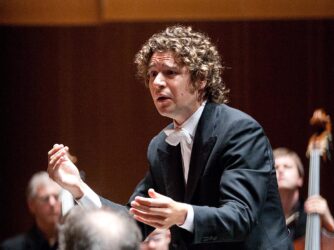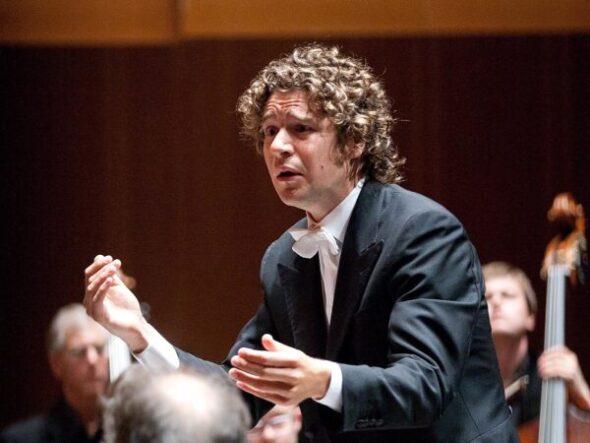 United States Mahler, Widmann: Ying Fang (soprano), Alina Ibragimova (violin), San Francisco Symphony / Robin Ticciati (conductor). Davies Symphony Hall, San Francisco, 20.1.2023. (HS)
United States Mahler, Widmann: Ying Fang (soprano), Alina Ibragimova (violin), San Francisco Symphony / Robin Ticciati (conductor). Davies Symphony Hall, San Francisco, 20.1.2023. (HS)

Jorg Widmann – Violin Concerto
Mahler – Symphony No.4 in G major
Conductor Robin Ticciati made an impressive, and long overdue, debut with the San Francisco Symphony on Friday in a Mahler Symphony No.4 that unrolled with mesmerizing specificity. He and the orchestra found a wonderful musical arch in the piece’s hodgepodge of mini-episodes.
Ticciati is no stranger to American audiences, having made splashes with the Philadelphia and Cleveland orchestras and at the Metropolitan Opera in New York. His credentials include positions as music director of the Deutsches Symphonie-Orchester Berlin, music director of Glyndebourne Festival Opera and (until 2018) principal conductor of the Scottish Chamber Orchestra. This experience and maturity showed up big-time in a program that featured Mahler’s sunniest symphony and contemporary German composer Jorg Widmann’s densely packed Violin Concerto.
In the Mahler, Ticciati shaped phrases with sensitive rubato and a natural feel for dynamics and orchestral balance. Smooth tempo shifts made the melodies cohere as they bounced around the orchestra (a notable feature of this symphony). The result was a performance that unfolded gracefully, with a sense of inevitability.
This orchestra knows its way around Mahler, as is demonstrated in its complete compilation of all the symphonies and other big orchestral works under former music director Michael Tilson Thomas from the early 2000s. The principals excelled, from concertmaster Alexander Barantschik to trumpeter Mark Inouye, timpanist Edward Stephan and percussionist Jacob Nissly (on sleigh bells), each contributing a range of subtle flavors with their own moments in the sun.
Tempo shifts in the first movement’s bouncy opening, with its rustic tunes and responses from other parts of the orchestra, felt utterly natural. The development turned this way and that gracefully, and the second movement Scherzo, with its eerie-yet-jaunty solos on the concertmaster’s extra violin tuned a whole tone up, proceeded with plenty of juice, albeit quietly and barely held back.
The glories, however, were the soul-hugging Adagio third movement and the extraordinary finale, a song of both humor and beauty that ended with a whisper in suspended silence.
The Adagio played out with sonorous texture and a gentle pulse that made the long lines glow. Toward the end of the slow-paced theme and variations, the waves of soft sounds shifted into a glorious mode as the full orchestra ventured into an E-major climax before subsiding again in the home key of G major. That was beautifully articulated by all hands.
The finale brought out soprano Ying Fang, a familiar figure both with the symphony and the opera here. Her creamy voice and elegant stature lavished lovely personality on the recurring final lines of each verse. The song, which Mahler adapted from ‘Der Himmel hängt voll Geigen’ (‘Heaven Is Hung with Violins’), one of his Wunderhorn songs, describes a heaven of distinctly human character in which ‘We dance and leap, we jump and sing’. The song describes delicious food and the last verse focuses on the music. It all ends on a heart-melting musical phrase that Fang delivered perfectly.
Before intermission, Russian violinist Alina Ibragimova, who plays in the Chiarascuro Quartet and concertizes mostly in Europe, made her San Francisco Symphony debut with the Widmann concerto from 2007. It proved to be a half hour of thickly packed, frankly dissonant polyphony, even though the composer’s program note stressed that he wanted the piece to be all about making the instrument sing.
That it does, and Ibragimova played it with plenty of heart and soul, but with little rhythm to leaven the textures it can be rough going for a listener. Ticciati, for his part, focused on keeping everything together, leaving the emotional content to the soloist, who never stops playing. I for one would have appreciated more spaciousness in the orchestra’s contributions, which often overwhelmed the individual violin. Not until the final phrases did the music find a much-needed subtlety, as it finished with a welcome hush.
Harvey Steiman
